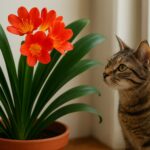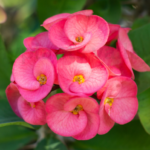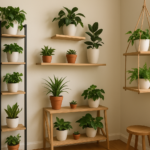Hoya Heuschkeliana Variegata is known for its stunning variegated foliage and unique patterns. In this comprehensive guide, we will dive deep into the world of this plant, exploring its origins, characteristics, and secrets to successfully growing and caring for it. Whether you’re a seasoned plant collector or a beginner looking to add a touch of elegance to your indoor garden, this guide will provide you with invaluable insights, practical tips, and expert advice. Get ready to embark on a journey of discovery and unlock the beauty and allure of Heuschkeliana Variegata!
Know Hoya Heuschkeliana Variegata
Hoya Heuschkeliana, also known as the Variegated Wax Plant, is a stunning plant that has captured the hearts of plant lovers worldwide. With its enchanting variegated foliage and intricate patterns, this plant adds a touch of elegance and beauty to any space.
This is native to Southeast Asia, particularly regions like Thailand and Malaysia. It belongs to the genus Hoya, which is a part of the Apocynaceae family. It comprises approximately 200 species of evergreen perennial vines.

Physical Characteristics
The leaves of Hoya Heuschkeliana Variegata are typically thick, waxy, and succulent, giving them a glossy appearance. They are typically heart-shaped, measuring around 2 to 4 inches in length. The leaf edges may be slightly ruffled, adding a touch of texture to the overall look.
Natural Habitat
In its natural habitat, this plant can be found growing on trees or rocks, using its aerial roots to anchor itself. It thrives in warm and humid environments, making it well-suited for indoor cultivation.
Variegation of Hoya Heuschkeliana Variegata
The variegation refers to the distinct color variations on the leaves, creating an enchanting display of contrasting hues. It is a result of a genetic mutation that affects the distribution of chlorophyll in the leaves. This mutation leads to the development of areas with reduced chlorophyll content, resulting in stunning variegation patterns.
The variegation of Heuschkeliana Variegata can range from creamy whites and soft yellows to light greens and deep emerald shades.
The variegation patterns on each leaf can vary, making each plant a unique work of art. Some leaves may exhibit random splashes or speckles of variegation, while others may have well-defined stripes or marbling effects. The variegated areas often appear as irregular patches or streaks, beautifully intertwining with the predominantly green color.
As the plant matures and grows, the variegation may become more pronounced, enhancing its visual appeal. However, it’s important to note that variegated leaves often contain less chlorophyll, which can affect the plant’s ability to photosynthesize. Therefore, providing adequate light is crucial to ensure the plant’s overall health and vitality.
Why Choose Hoya Heuschkeliana Variegata?
Beauty and Aesthetic Appeal
Heuschkeliana Variegata’s stunning variegated foliage adds a touch of elegance and visual interest to any space. Whether displayed as a cascading vine or trained to climb a trellis, this plant is sure to be a conversation starter and a focal point in your indoor garden.
Variegation as a Unique Feature
The variegation of Hoya Heuschkeliana Variegata is a truly unique feature that sets it apart from other plants. The intricate patterns and color combinations make each leaf a work of art. The variegation can vary not only between plants but also on individual leaves, making it a captivating and ever-changing display.
Low Maintenance Requirements
One of the reasons why Hoya Heuschkeliana Variegata is beloved by plant enthusiasts is its relatively low-maintenance nature. It is a resilient plant that can adapt to a variety of indoor conditions. With proper care, it can thrive and bring beauty to your space with minimal effort.
Air-Purifying Properties
In addition to its aesthetic appeal, Hoya Heuschkeliana also boasts air-purifying qualities. Like other Hoyas, it can filter and cleanse the air by removing pollutants and releasing oxygen. Having this plant in your living or working space can contribute to improved air quality and a healthier environment.
Hoya Heuschkeliana Variegata Care
Light Requirements
Hoya Heuschkeliana thrives in bright, indirect light. It prefers a few hours of morning or evening sun, but direct sunlight during the hottest parts of the day should be avoided as it can scorch the leaves. Place your plant near a north or east-facing window for optimal light conditions.
Temperature Considerations
Hoya Heuschkeliana thrives in average to warm temperatures. Ideally, maintain temperatures between 60°F (15°C) and 80°F (27°C). Avoid exposing the plant to sudden temperature fluctuations or cold drafts, as it can be sensitive to temperature changes. Protect it from frost, as it is not frost-tolerant.
Humidity
This plant appreciates moderate to high humidity levels. Aim for a humidity range of 50% to 60%, if possible. In drier environments, you can increase humidity by placing the plant on a pebble tray filled with water or by using a humidifier. Misting the leaves occasionally can also help provide some moisture.
Watering Needs
Proper watering is crucial for the well-being of Heuschkeliana Variegata. Water the plant thoroughly and allow the top inch of soil to dry out before the next watering. Overwatering should be avoided as it can lead to root rot. Allow the soil to dry partially between waterings. During the growing season, which is typically spring and summer, increase watering frequency, but still ensure the soil has adequate drainage.
Soil Type
Hoya Heuschkeliana prefers a well-draining soil mix. A combination of peat moss, perlite, and orchid bark works well for this plant. The soil should allow excess water to drain freely to prevent the roots from becoming waterlogged, which can lead to root rot.
Fertilization
Feed Hoya Heuschkeliana Variegata with a balanced, water-soluble fertilizer during the growing season. Dilute the fertilizer to half the recommended strength and apply it every two to four weeks. Reduce or stop fertilization during the winter months when the plant enters a period of dormancy.
Pot size
Hoya Heuschkeliana Variegata is a relatively slow-growing plant, and it doesn’t require frequent repotting. When selecting a pot, choose one that provides enough room for the plant’s roots to grow and develop. A pot with a diameter of 6 to 8 inches (15 to 20 cm) is usually sufficient for small to medium-sized specimens. If you have a larger plant or want it to grow bigger, you can opt for a slightly larger pot. Avoid using excessively large pots, as they can retain too much moisture and potentially lead to root rot.
Drainage
Good drainage is crucial for the health of Hoya Heuschkeliana Variegata. This plant dislikes sitting in waterlogged soil, as it can cause root rot and other moisture-related issues. Ensure that your pot has drainage holes at the bottom to allow excess water to escape. When watering the plant, water thoroughly until water drains out of the bottom of the pot, and then empty the saucer or tray underneath to prevent the roots from sitting in standing water.
Potting mix
Alongside proper drainage, the potting mix used for Hoya Heuschkeliana Variegata should promote good airflow and moisture retention without becoming overly compacted. A well-draining mix, such as a combination of peat moss, perlite, and orchid bark, is ideal. This mix allows excess water to drain away while retaining some moisture for the roots.
Repotting
Hoya Heuschkeliana Variegata generally doesn’t require frequent repotting. Repotting is typically done when the plant has outgrown its current pot or when the soil has become compacted and retains too much moisture. When repotting, gently loosen the root ball and place the plant in a slightly larger pot with fresh potting mix. Avoid burying the plant too deep, as it prefers to have its roots close to the surface.
Pruning Tips for Hoya Heuschkeliana Variegata</span></h2>
Shape and Size Control
Pruning is essential for maintaining the shape and size of your Hoya Heuschkeliana Variegata. Trim back excessive growth or long vines to promote bushier growth and a more compact appearance. Use clean, sharp pruning shears to make precise cuts just above a leaf node.
Removing Dead or Damaged Foliage
Regularly inspect your plant for any dead or damaged foliage. Removing these leaves not only improves the plant’s appearance but also prevents the spread of diseases or pests. Trim off any yellowed, brown, or withered leaves to maintain the plant’s vitality.
Cleaning and Grooming the Leaves
The glossy leaves of Hoya Heuschkeliana Variegata can accumulate dust over time, affecting their beauty and hindering photosynthesis. Gently wipe the leaves with a soft, damp cloth or use a mild, organic leaf shine spray to keep them clean and vibrant. This will enhance their natural shine and allow them to absorb more light.
Fertilizing Routines
To support healthy growth and vibrant variegation, fertilize your Hoya Heuschkeliana Variegata regularly. Use a balanced, water-soluble fertilizer diluted to half strength and apply it during the growing season, typically from spring to summer. Follow the package instructions for dosage and frequency, as over-fertilization can lead to leaf burn.
Hoya Heuschkeliana Variegata Propagation
Propagation of Hoya Heuschkeliana Variegata, commonly known as the variegated wax plant or the porcelain flower, is an exciting process that allows plant enthusiasts to reproduce this beautiful and unique plant. There are several methods to propagate Hoya Heuschkeliana Variegata, such as:
Stem Cutting Propagation
Propagating Hoya Heuschkeliana Variegata through stem cuttings is a popular and effective method. Select a healthy stem and using a clean, sharp pair of scissors or pruning shears, cut the stem just below a node. Remove the lower leaves, leaving a few at the top. Place the cutting in a well-draining rooting medium and keep it in a warm, humid environment. After a few weeks, roots will begin to develop, and you can transfer the cutting to a pot with a suitable potting mix.
Leaf Cutting Propagation
Leaf-cutting propagation is another method to expand your collection of Hoya Heuschkeliana Variegata. Select a healthy leaf and make a clean cut, ensuring a small portion of the stem is attached. Place the leaf in a moist rooting medium, burying the stem slightly. Keep the cutting in a warm and humid environment, misting it occasionally. Over time, small plantlets will emerge from the base of the leaf, and you can transplant them into individual pots.
Propagation from Offsets
Hoya Heuschkeliana Variegata occasionally produces offsets, also known as “pups.” These small plantlets can be carefully separated from the mother plant once they have developed a few roots. Plant the offsets in their own pots, ensuring they have well-draining soil and provide the same care as mature plants.
Displaying Hoya Heuschkeliana Variegata&lt;/span></h2>
Containers and Potting Options
Choose a well-draining pot with drainage holes to ensure excess water can escape. Terra cotta or ceramic pots are popular choices as they allow for better airflow and water evaporation. Consider using hanging baskets, trellises, or macrame plant hangers to showcase the trailing nature of Hoya Heuschkeliana Variegata.</p>
Vertical Gardening and Hanging Baskets
Take advantage of Hoya Heuschkeliana Variegata’s trailing habit by incorporating it into vertical gardens or hanging baskets. This not only maximizes space but also creates an eye-catching display. Combine it with other trailing plants or mix different Hoya varieties for a stunning and diverse arrangement.
Complementary Plants and Arrangements</h3>
Hoya Heuschkeliana Variegata can be paired with various plants to create visually appealing combinations. Consider companion plants with contrasting textures and colors to accentuate the variegation. Plants like Pothos, Philodendron, or Ferns can create a lush and tropical display alongside your Hoya.
lass=”yoast-text-mark”>=”fon
t-weight: 400;”>Creating a Hoya Heuschkeliana Variegata Terrarium
A terrarium can be an enchanting way to showcase Hoya Heuschkeliana Variegata. Select a glass container with a lid to create a mini greenhouse effect. Fill it with a well-draining soil mix, and arrange the plant along with decorative elements like pebbles or moss. The enclosed environment helps to maintain high humidity levels, making it suitable for the plant’s growth.
Pests
and Diseases of Hoya Heuschkeliana Variegata</span></h2&gt;
Hoya Heuschkeliana Variegata, like other plants, can be susceptible to certain pests and diseases. Here are some common issues to be aware of when caring for this plant:
Pests
Aphids
<span style=”font-weight: 400;”>These small, soft-bodied insects can infest Hoya Heuschkeliana Variegata, usually congregating on the undersides of leaves and the tips of new growth. Aphids feed on plant sap, causing leaves to become distorted and yellowed. To control aphids, you can gently wash them off the plant with a strong stream of water or use insecticidal soap or neem oil, following the instructions on the product label.
Mealybugs
le=”font-weight: 400;”>Mealybugs are another common pest that can affect Hoya Heuschkeliana Variegata. They appear as small, cottony clusters, often found in leaf axils or on the undersides of leaves. Mealybugs feed on plant sap and excrete honeydew, leading to a sticky residue and attracting ants. To treat mealybug infestations, remove them manually using a cotton swab dipped in rubbing alcohol or use insecticidal soap or neem oil.
Scale insects
Scale insects are small, immobile pests that attach themselves to the stems and leaves of Hoya Heuschkeliana Variegata. They have a protective shell-like covering, making them challenging to eradicate. The insects feed on plant sap and can cause yellowing, stunted growth, and leaf drop. To control scale insects, gently scrape them off with a soft brush or cloth, or use insecticidal oil or neem oil, ensuring thorough coverage of the affected areas.
Diseases
Leaf spots</span>
Hoya Heuschkeliana Variegata may develop leaf spots, which can be caused by fungal or bacterial infections. Leaf spots often appear as discolored or darkened areas on the leaves. To prevent leaf spots, avoid overhead watering and ensure good air circulation around the plant. If leaf spots occur, remove and dispose of the affected leaves and adjust watering practices. Fungicidal sprays can be used if the problem persists.
Root rot
tyle=”font-weight: 400;”>Overwatering or poorly draining soil can lead to root rot in Hoya Heuschkeliana Variegata. Root rot is caused by fungal pathogens that thrive in excessively moist conditions. Symptoms include wilting, yellowing leaves, and a foul odor from the soil. To prevent root rot, ensure proper drainage by using well-draining soil and pots with drainage holes. Allow the soil to partially dry between waterings and avoid overwatering.
Regularly inspecting your Hoya Heuschkeliana Variegata for signs of pests or diseases and taking prompt action can help keep your plant healthy.
Frequently Asked Questions (FAQs)
Are variegated Hoya rare?
Yes, variegated Hoyas are rare due to genetic mutations that cause unique leaf coloration. Their striking foliage, displaying patterns of white, yellow, or cream, has increased their demand and value among plant enthusiasts.
<span style=”font-weight: 400;”>What is the difference between Hoya Heuschkeliana variegata and Krimson Princess?
“font-weight: 400;”>The difference between Hoya Heuschkeliana variegata and Krimson Princess lies in their leaf variegation patterns. Hoya Heuschkeliana variegata features broader, irregularly shaped variegation in creamy yellow or white, while Krimson Princess has smaller, more uniform pink, red, or maroon variegation. Both varieties are cherished for their unique and eye-catching foliage.
le=”font-weight: 400;”>How do you care for Hoya Heuschkeliana variegata?</h3>
To care for Hoya Heuschkeliana variegata, provide it with bright, indirect light, moderate to high humidity, and well-draining soil. Water when the top inch of soil is dry, and avoid overwatering. Maintain temperatures between 60°F to 80°F (15°C to 27°C). Fertilize during the growing season, and address pests promptly. Prune if needed and repot when necessary.</span>
le=”font-weight: 400;”>Is Hoya Heuschkeliana Variegata toxic to pets or children?
style=”font-weight: 400;”>Hoya Heuschkeliana Variegata is generally non-toxic to pets and children. However, it’s always advisable to consult with a veterinarian or medical professional if you have any concerns about specific allergies or sensitivities.</span>
tyle=”font-weight: 400;”>Can I keep Hoya Heuschkeliana Variegata outdoors all year round?
style=”font-weight: 400;”>Hoya Heuschkeliana Variegata is generally suitable for outdoor cultivation in regions with a mild and consistent climate. However, it may require protection or be brought indoors during colder or harsher weather conditions to prevent damage from frost or extreme temperatures.
style=”font-weight: 400;”>Conclusion</h2>
In conclusion, Hoya Heuschkeliana Variegata is a captivating plant that appeals to plant lovers and enthusiasts. Its unique variegation patterns, low maintenance requirements, and air-purifying properties make it a dream addition to any plant collection. By understanding its origins, ideal conditions, propagation methods, and care guidelines, you can cultivate and enjoy the beauty of Hoya Heuschkeliana Variegata in your own space.
So, Start cultivating and experiencing the wonders of this plant today!
Happy gardening!
Also, read-







